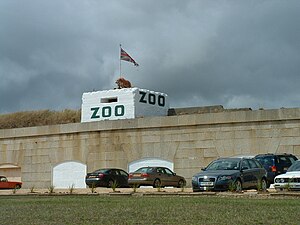Isle of Wight Zoo

Isle of Wight Zoo logo
|
|
 |
|
| Location | Sandown, Isle of Wight, England |
|---|---|
| Coordinates | 50°39′39″N 1°08′22″W / 50.6609°N 1.1394°WCoordinates: 50°39′39″N 1°08′22″W / 50.6609°N 1.1394°W |
| Major exhibits | Tigers, lemurs |
| Website | http://www.isleofwightzoo.com/ |
The Isle of Wight Zoo, previously known as the Sandown Zoo is a sanctuary inside a fort on the coastline of Sandown, Isle of Wight. The zoo is privately owned, and the collection focuses principally on big cats and Madagascan animals.
As part of the European Endangered Species Programme, the zoo has had success breeding several species of Madagascan animals including the critically endangered black-and-white ruffed lemur.
Originally known as Sandown Zoo, the zoo was established in the 1950s. By the 1970s it had fallen into disrepair, and was dubbed "The Slum Zoo of Britain" by the Sunday Times. However, in 1976 the zoo was taken over by a new owner, and over the following years it was rebuilt as a sanctuary for big cats and primates.
The zoo is currently home to seven tigers, four African lions and two jaguars. The most famous of the big cats is Zena, the zoo's only white tiger. A single male golden tiger, Diamond, also resides in the zoo.
In recent years, three Indian themed enclosures have opened featuring glass viewing panels, ponds, natural planting and themed statues and temples. These enclosures were designed and built with the assistance of Ecclestone George Public Artists.
The zoo also has a Madagascan theme, and the primate section reflects this by specialising in lemurs. It houses ring-tailed, black-and-white ruffed, red ruffed, black, white-fronted brown and mongoose lemurs, several of which have bred in recent years as part of European breeding programmes.
The primate section is also home to spider monkeys and capuchins.
...
Wikipedia
